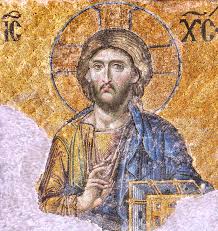There are two multiplication of the loaves, which makes it evident that they are concerned with more than merely feeding the crowds. The first came after the raising from the dead of the daughter of Jairus, when Jesus had said to her parents, “Give her something to eat” (5.43). This very phrase was repeated when Jesus told his disciples to feed the crowd in the desert: “You give them something to eat” (6.37). And five loaves fed five thousand men, with twelve baskets of fragments collected after all had eaten. The second multiplication of the loaves came after the cure of the possessed daughter of the Syro-Phoenician woman, that is, of a gentile (7.24-30). When Jesus at first refused her plea with apparent rudeness—“It is not right to take the children’s bread and throw it to the dogs”—she wittily replied, “Yes, Lord; yet even the dogs under the table eat the children’s crumbs.” Another reference to eating leads us to expect a second feeing of the multitude, but with a difference. The people fed were gentiles, for we are told that the miracle took place in the “the Decapolis” (7.31), i.e., in the region of the ten cities east of the Jordan River. This time there were seven loaves that feed four thousand people, with seven baskets of fragments collected. I call your attention to the numbers involved—this many loaves, that many people, and that many baskets of fragments—because Jesus himself underlines their importance:
“Do you not yet perceive or understand? . . . When I broke the five loaves for the five thousand, how many baskets full of broken pieces did you take up?” They said to him, “Twelve.” “And the seven for the four thousand, how many baskets full of broken pieces did you take up?” And they said to him, “Seven.” And he said to them, “Do you not yet understand?” (8.17-21)
Well, do you understand? Our Lord tells us that these events are significant, and he invites us—along with any number of exegetes—to ponder the matter. Let’s begin with what seems obvious in the first multiplication: five loaves fed five thousand, in other words, each loaf represents a thousand people. That’s clear enough. The number five is often taken as referring to the Jewish people, because the first five books of the Bible—the Torah—establish the covenants that constituted the Jews as the people of God. The number twelve—in the twelve baskets of fragments—is similarly suggestive, for there were twelve tribes in Israel. We see, then, that there is enough bread for the entire nation. We are led, therefore, to looking upon the feeding as a symbol of the Messianic banquet, that is to say, of the Messianic era. Jesus, as we see, fulfils all the hopes and expectations of the Jewish people.
In the second case the numbers are equally suggestive. There were seven loaves, which would have been enough for seven thousand people, but only four thousand were actually fed. We note first that seven is, like twelve, a number that signifies completion or perfection, as in the seven day of creation or the seven gifts of the Holy Spirit. The implication is that there was enough bread for a future feeding of all the gentiles, as we see from the fact that seven baskets were collected after the meal. That only four loaves would have been required for the four thousand leaves three loaves available for the thousands who were not present. It’s a short step to move from these considerations to recognizing that all the gentiles had not yet been invited to the Messianic banquet, but they will be, once the Apostles “make disciples of all nations” (Matt 28.19). And we know that a full seven baskets of fragments will be available to feed everyone.
If you head is spinning from all this arithmetic, let me point to the simplest number of them all: one: “Now they had forgotten to bring bread; and they had only one loaf with them in the boat” (8.14). It seems sometimes that Mark had a sense of humour, for, we must wonder, “What happened to all those baskets of fragments?” But we know from Saint Paul that the single loaf is symbolic of the Eucharist and of our being members of Christ’s Mystical Body: “Because there is one bread, we who are many are one body, for we all partake of the one bread” (I Cor 10.17). It is clear, therefore, that the multiplication of the loaves foreshadows the Eucharist, a fact that Mark underlines when he describes Jesus as “giving thanks,” (= “Eucharist” in Greek) over the loaves and “blessing” the fish. It follows that, however, fragmented the loaves may be, there is unity in the Church because of the one loaf, one bread of the Eucharist.[1]
[1] A fuller, more intricate discussion of these incidents can be found in Austin Farrer, A Study in St Mark (Westminster: Dacre Press, 1951), pp. 290-304.











